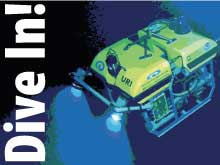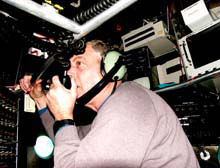
Lesson plans are available for this expedition. Download them from this page.
Exploring Alaska's Seamounts
Education
The Alaska Seamount Expedition brings together, scientists from many universities and research institutions to study several unexplored seamounts in the Gulf of Alaska (GOA) and try to understand how they formed and to determine their volcanic history. They will also characterize these unique habitats and explore the diverse communities of organisms such as fish and invertebrates that exist around these undersea mountains.

Senior Alvin Pilot Dudley Foster communicates observations to scientists aboard the Atlantis while exploring thousands of meters below the surface. Click image for larger view.
This expedition provides a wonderful opportunity to inform and excite the general public, as well as the scientific community, about unique and unexplored regions of the deep ocean environment. Undergraduate and graduate students will benefit through post-cruise presentations by cruise participants at their respective institutions. An undergraduate student from the University of Alaska's Marine Sciences Alaska Native and Minority Student Internship/Mentoring Program ![]() will participate in the cruise, as will a K-12 educator. The student and teacher will assist with the collection of material for the NOAA Ocean Explorer Web site, through which the general public will be able to follow the expedition. A team of professional videographers will be present throughout the cruise with the goal of developing an expedition video. This cruise will also provide an educational platform for the North Pacific Fisheries Observer Training Center, as one observer trainer will join the cruise, as will their new Director, Peter Risse. There is also potential for an Observer Training video to be developed from the footage collected during the Alvin dives.
will participate in the cruise, as will a K-12 educator. The student and teacher will assist with the collection of material for the NOAA Ocean Explorer Web site, through which the general public will be able to follow the expedition. A team of professional videographers will be present throughout the cruise with the goal of developing an expedition video. This cruise will also provide an educational platform for the North Pacific Fisheries Observer Training Center, as one observer trainer will join the cruise, as will their new Director, Peter Risse. There is also potential for an Observer Training video to be developed from the footage collected during the Alvin dives.
Classroom teachers working with NOAA during May 2002 developed a series of lesson plans for students in Grades 5 – 12 that are specifically tied to the Alaska Seamount Expedition. These lesson plans focus on cutting-edge ocean exploration and research, using state-of-the-art technology, aboard one of the nation's most sophisticated research vessels, the R/V Atlantis and its submersible Alvin, which are owned and operated by the Woods Hole Oceanographic Institute. The lesson plans focus specific all on the importance of ocean exploration and the research taking place during the Alaska Seamount Expedition, and feature such topics as how seamounts form, how depth effects biological communities, and what deep water corals can tell us about long term patterns of climate change.
Below are descriptions of lesson plans developed for students in Grades 5 - 12 specifically tied to the Alaska Seamount Expedition.
The lesson plans are grouped into the following categories:
Grades 5-6
Grades 7-8
Grades 9-12 (chemical, biological, earth, and physical science)
All of the lesson plans are available in pdf format, and may be viewed and printed with the free Adobe Acrobat Reader ![]() . To download a lesson plan, click on its title from the list below.
. To download a lesson plan, click on its title from the list below.
Each grade-level grouping includes one activity that introduces students to ocean exploration in general, and additional activities that focus on the exploration and research being conducted as part of the Alaska Seamount Expedition. In addition to being tied to the National Science Education Standards, the hands-on, inquiry-based activities include focus questions, background information for teachers, links to interesting Internet sites, and extensions. Another significant component for each activity is a section that includes adaptations for deaf students. Web logs that document the latest discoveries and complement the lesson plans, complete with compelling images and video, will be sent back each day from sea. Teachers are encouraged to use the daily logs from the Alaska Seamount Expedition, which are posted on this site, to supplement the lesson plans.
Grades 5-6
Feeling Crabby? (8 pages, 368k)
Focus: The effect of depth on deep-water crab reproductive biology in the Gulf of Alaska
In this activity, students will analyze data from a simulated sampling program to investigate the influence of water depth on size at reproductive maturity among deep-water crab populations, interpret results of their sampling program to draw conclusions about changes in size at reproductive maturity associated with water depth, and apply their results to draw conclusions about appropriate fishery regulations to protect reproductive opportunity among deep-water crab populations.
Volcanoes, Plates, and Chains (7 pages, 116k)
Focus: Formation of seamounts the Axial-Cobb-Eikelberg-Patton chain, Gulf of Alaska
In this activity, students will be able to describe the processes that form seamounts, describe the movement of tectonic plates in the Gulf of Alaska region and explain the types of volcanic activity that might be associated with these movements, and describe how a combination of hotspot activity and tectonic plate movement could produce the arrangement of seamounts observed in the Axial-Cobb-Eikelberg-Patton chain.
Grades 7-8
Biological Communities of Alaska Seamounts (5 pages, 108k)
Focus: Biological Communities of Alaska Seamounts
In this activity, students will be able to infer why biological communities on seamounts are likely to contain unique or endemic species, calculate an index of similarity between two biological communities given species occurrence data, make inferences about reproductive strategies in species that are endemic to seamounts, and explain the implications of endemic species on seamounts to conservation and extinction of these species.
Mapping Seamounts in the Gulf of Alaska (5 pages, 176k)
Focus: Physical description and mapping of seamounts in the Axial-Cobb-Eikelberg-Patton chain
In this activity, students will describe major topographic features on the Patton Seamount, interpret two-dimensional topographic data, and create a three-dimensional model of landforms from two-dimensional topographic data.
Grades 9-12
Breaking Away (Or Not . . .) (5 pages, 96k)
Focus: Life Science - Reproductive/developmental strategies of some benthic seamount species
In this activity, students will be able to compare and contrast common reproductive strategies used by benthic invertebrates, describe the most common reproductive strategies among benthic invertebrates on a seamount and explain why these strategies are appropriate to seamount conditions, describe how certain reproductive strategies favor survival of species on seamounts and what changes on seamounts might favor other strategies, and discuss the implications of reproductive strategy to the conservation and protection of seamount communities.
History's Thermometers (5 pages, 80k)
Focus: Physics – Use of deep-water corals be used to determine long-term patterns of climate change
In this activity, students will be able to explain the concept of paleoclimatological proxies, learn how oxygen isotope ratios are related to water temperature, and interpret data on oxygen isotope ratios to make inferences about climate and climate change in the geologic past.
Mystery of the Alaskan Seamounts (9 pages, 132k)
Focus: Earth Science - Formation of seamounts in the Axial-Cobb-Eikelberg-Patton chain, Gulf of Alaska
In this activity, students will be able to describe the processes that form seamounts, learn how isotope ratios can be used to determine the age of volcanic rock, and interpret basalt rock age data from seamounts in the Gulf of Alaska to investigate a hypothesis for the origin of these seamounts.
Rock Eaters of the Gulf of Alaska (8 pages, 104k)
Focus: Chemistry, Biology, Earth Science - Chemosynthetic microbes in basalt rocks
In this activity, students will be able to compare and contrast the processes of photosynthesis and chemosynthesis, identify and describe sources of energy used by various organisms for chemosynthesis, and predict what chemosynthetic reactions might be possible in selected “extreme” environments.
For More Information
Please contact Paula Keener-Chavis, National Education Coordinator for the NOAA Office of Ocean Exploration if you have questions about these lesson plans or if you need additional information about their development.
Contact Paula Keener-Chavis,
Director, Education Programs
NOAA Office of Ocean Exploration
Other lesson plans developed for this Web site are available in the Education Section.
Sign up for the Ocean Explorer E-mail Update List.


























